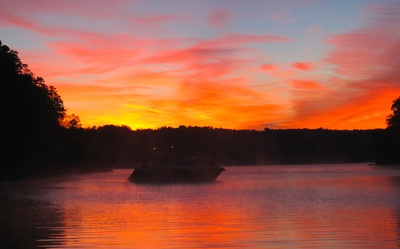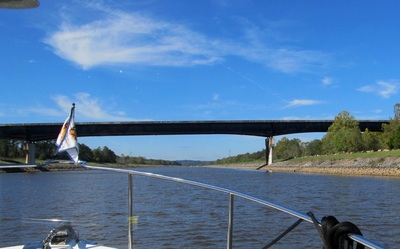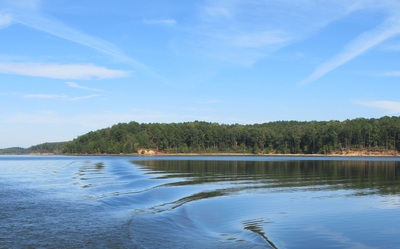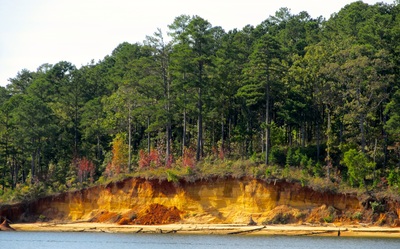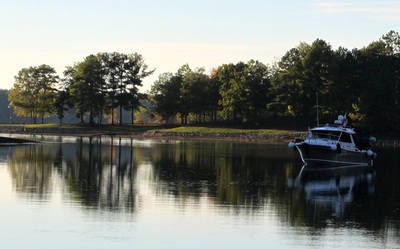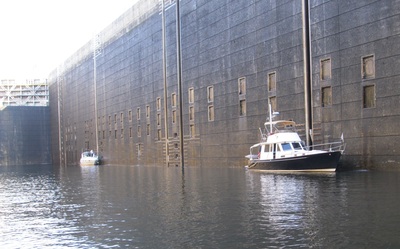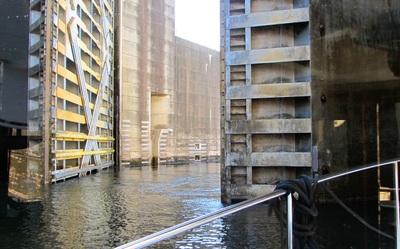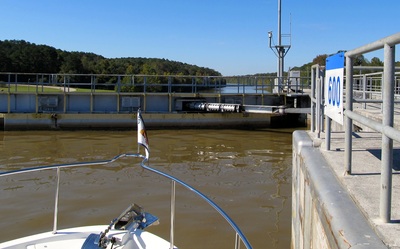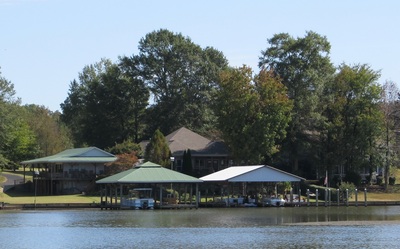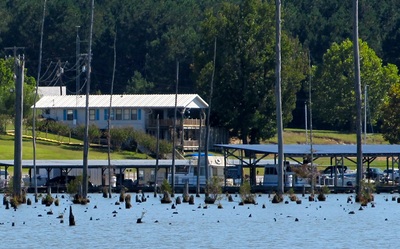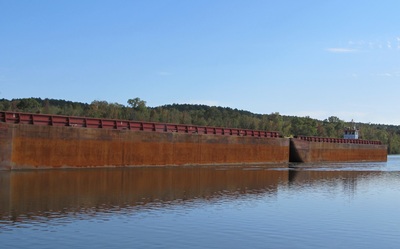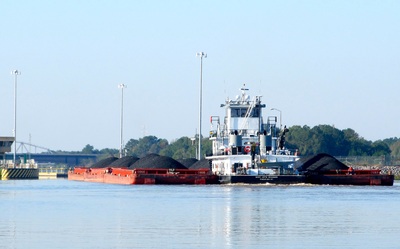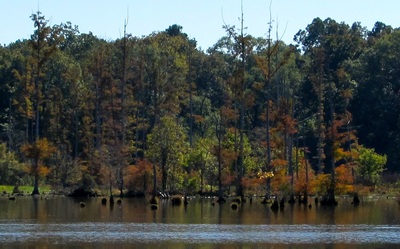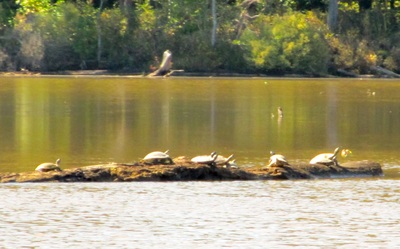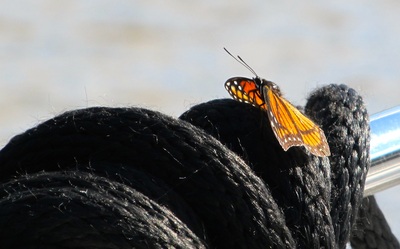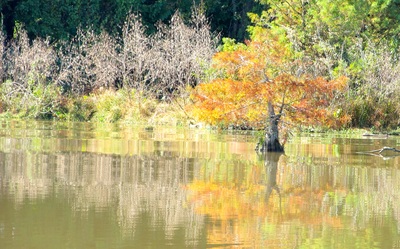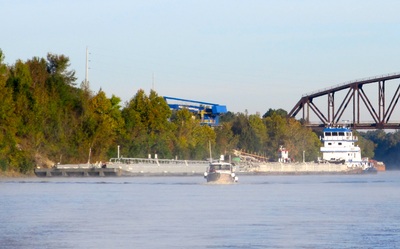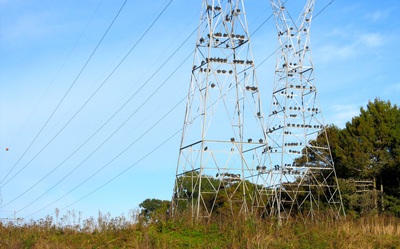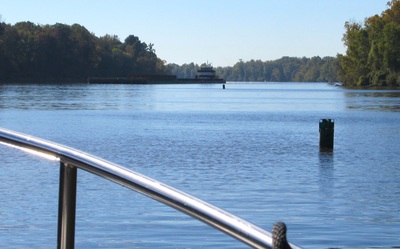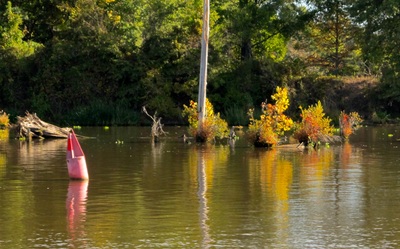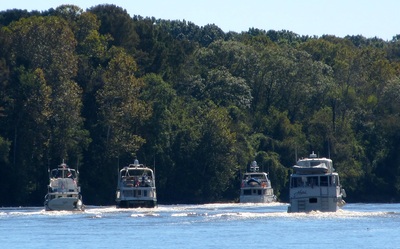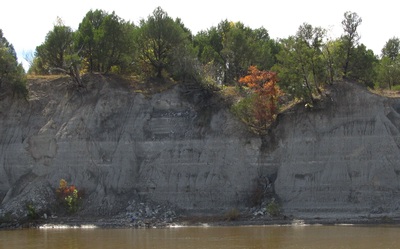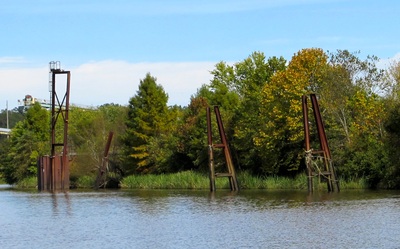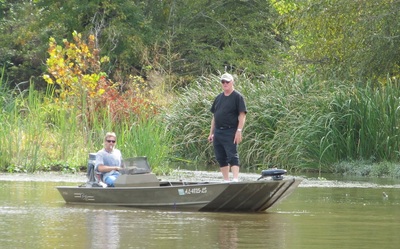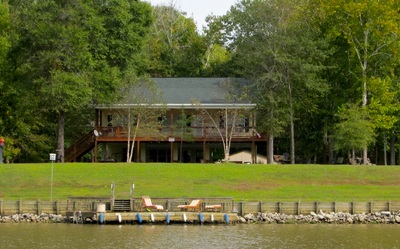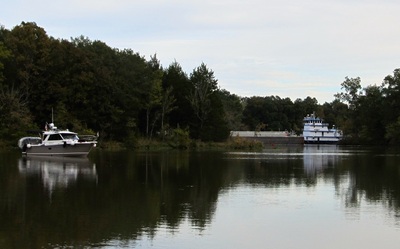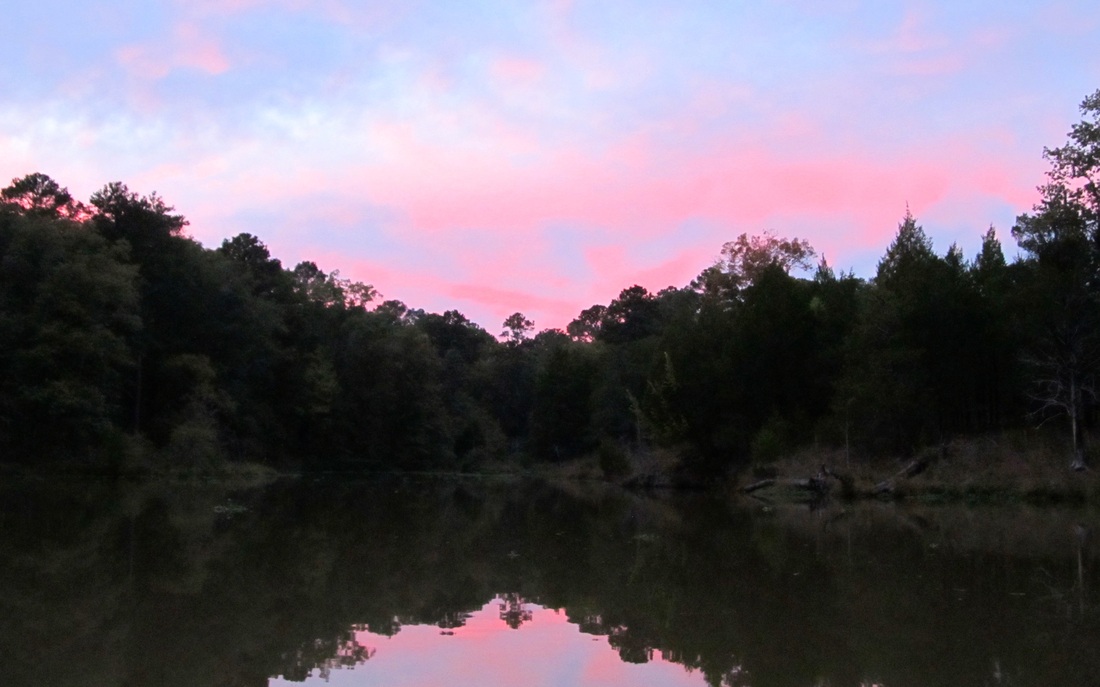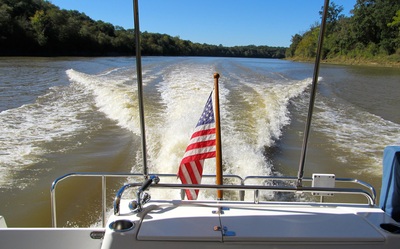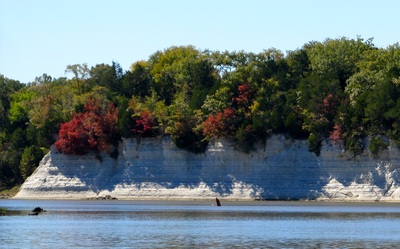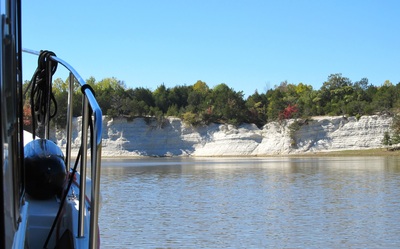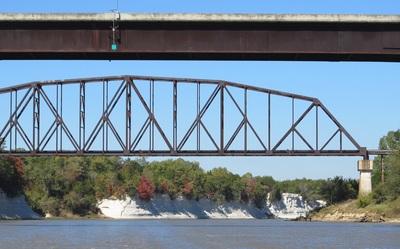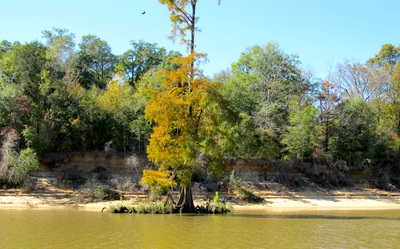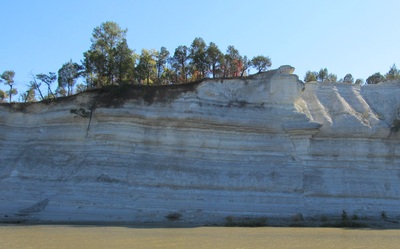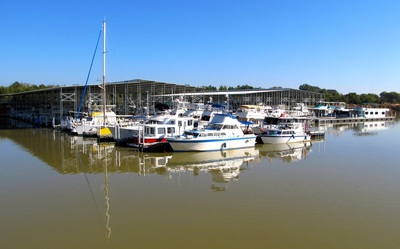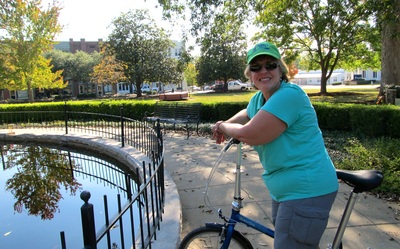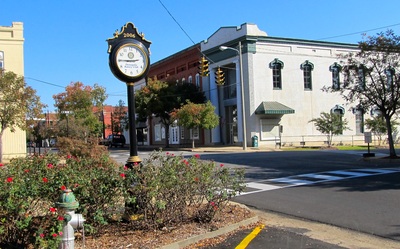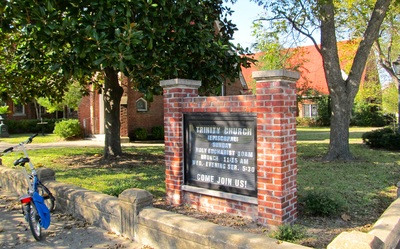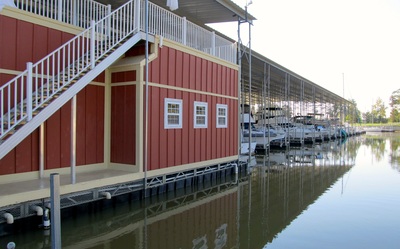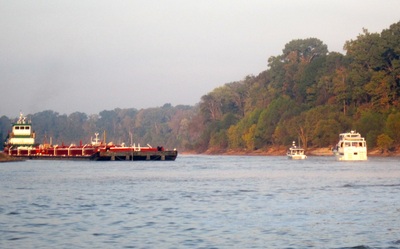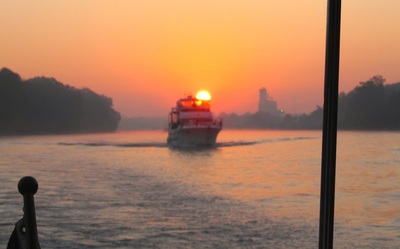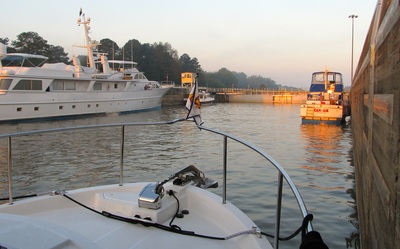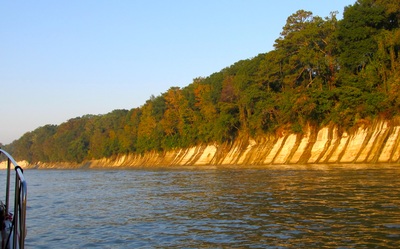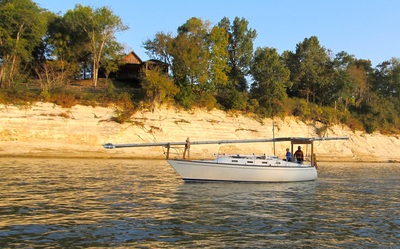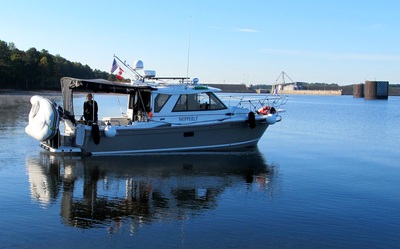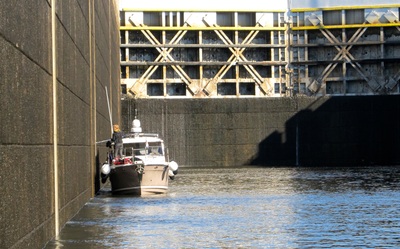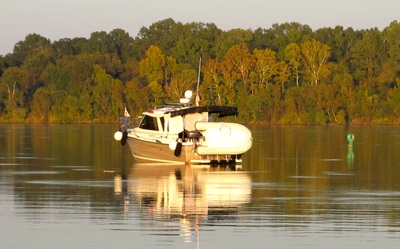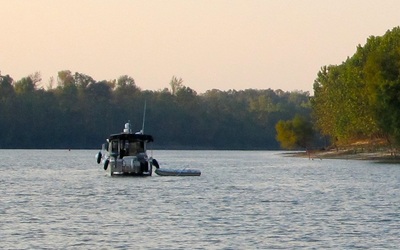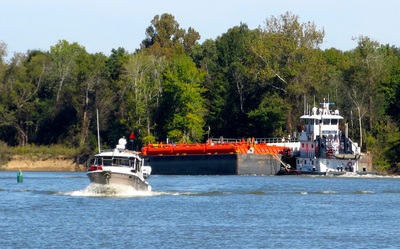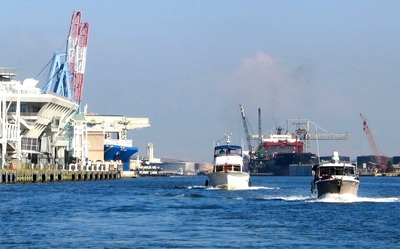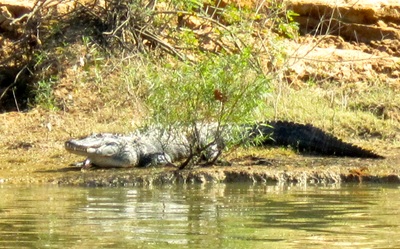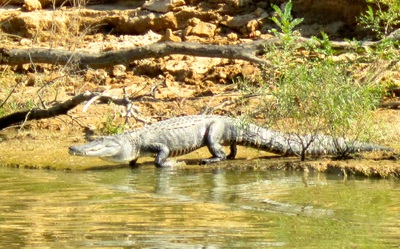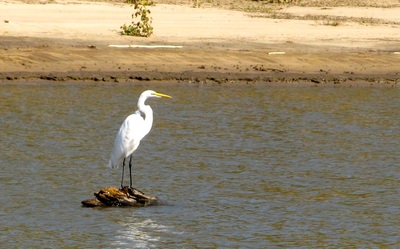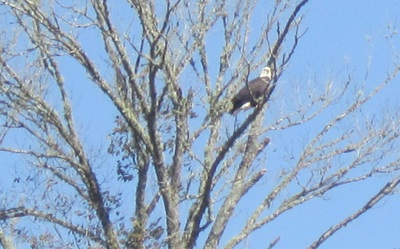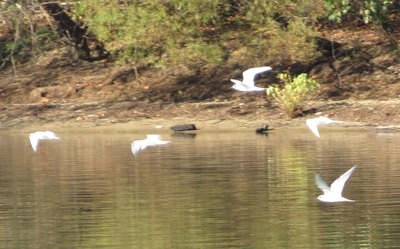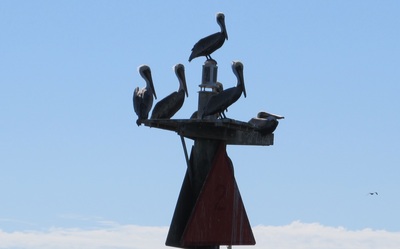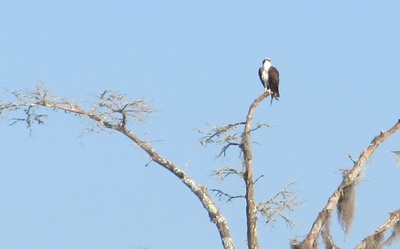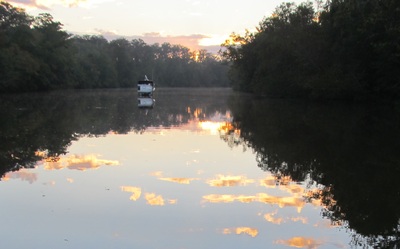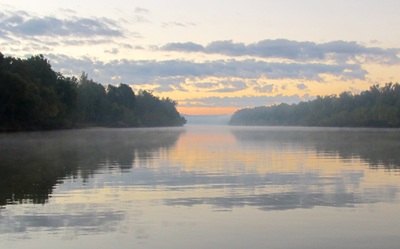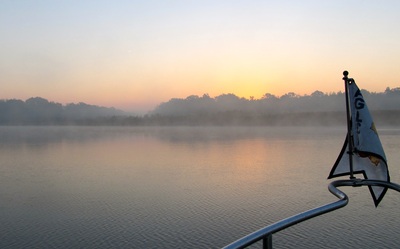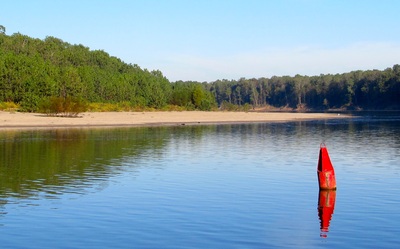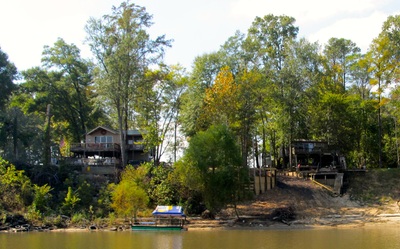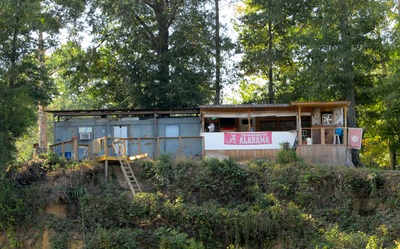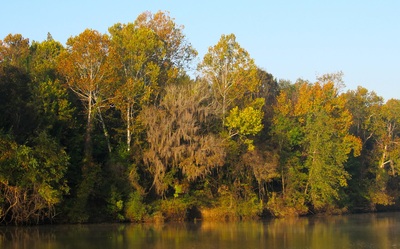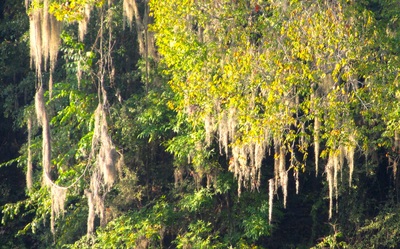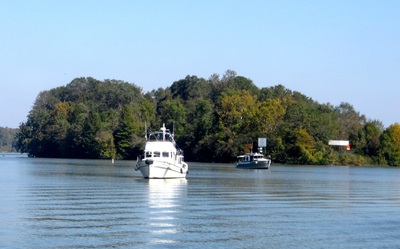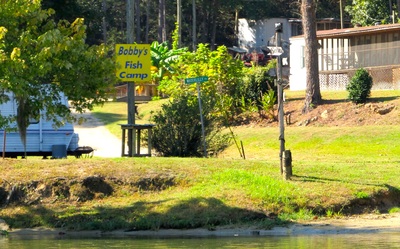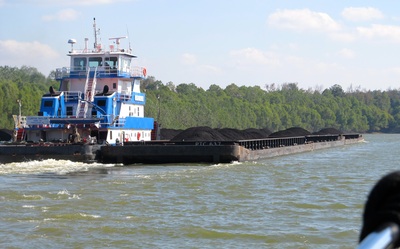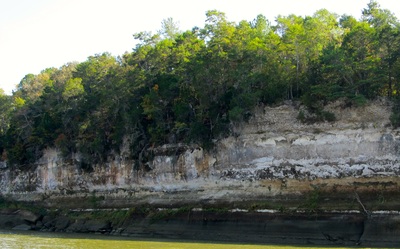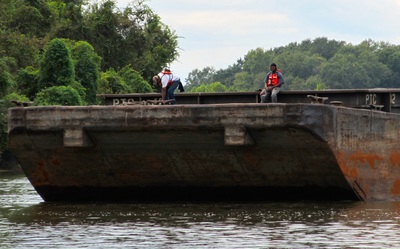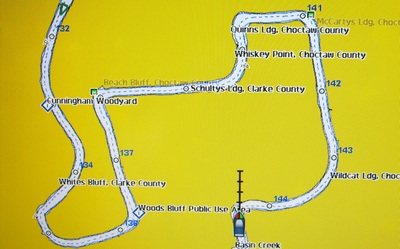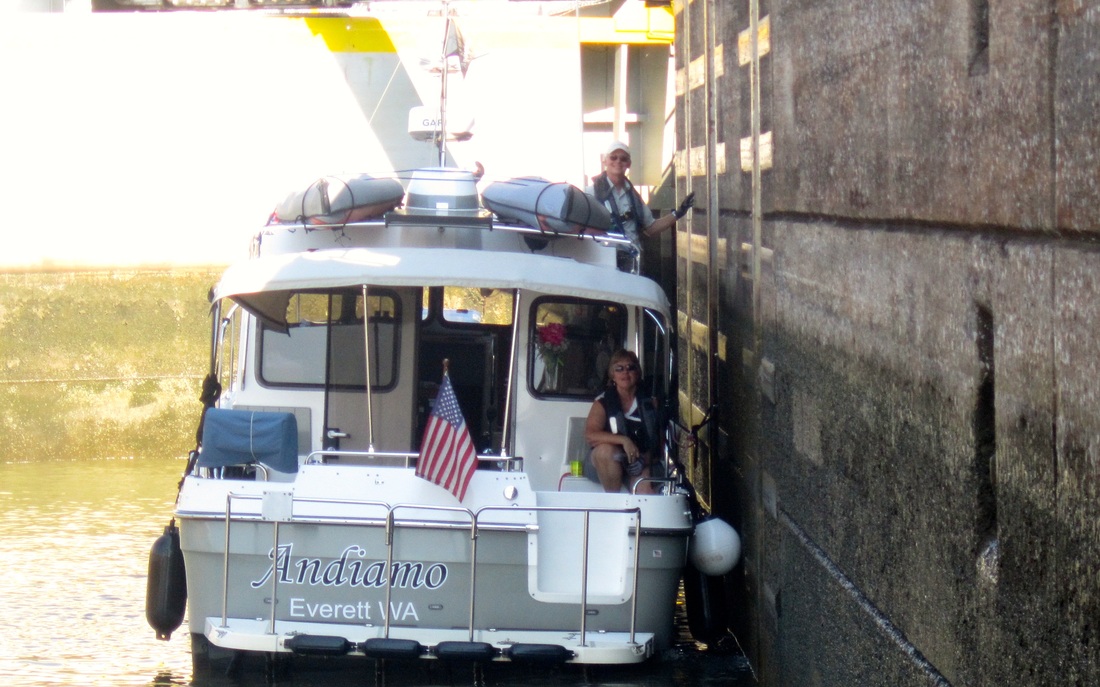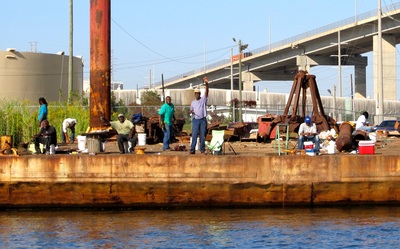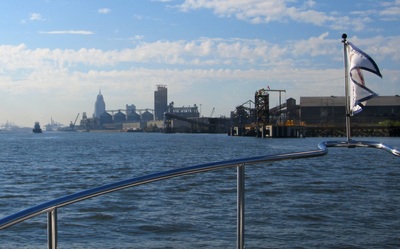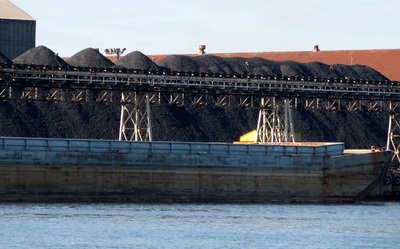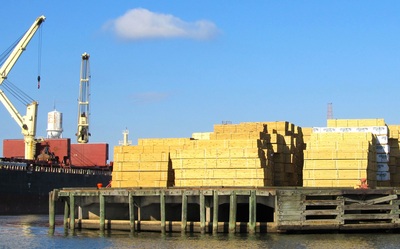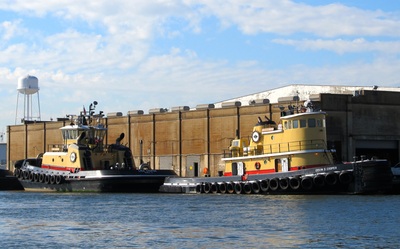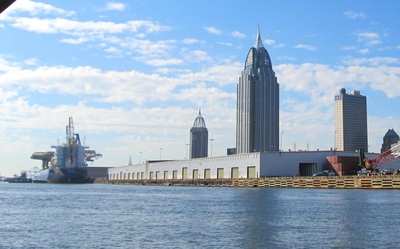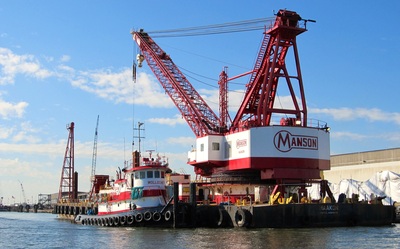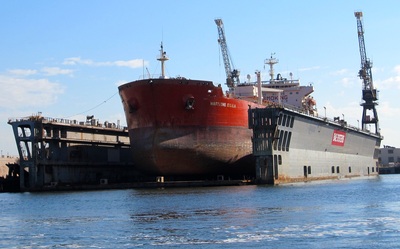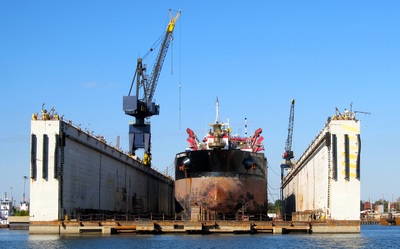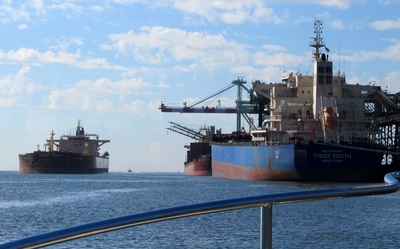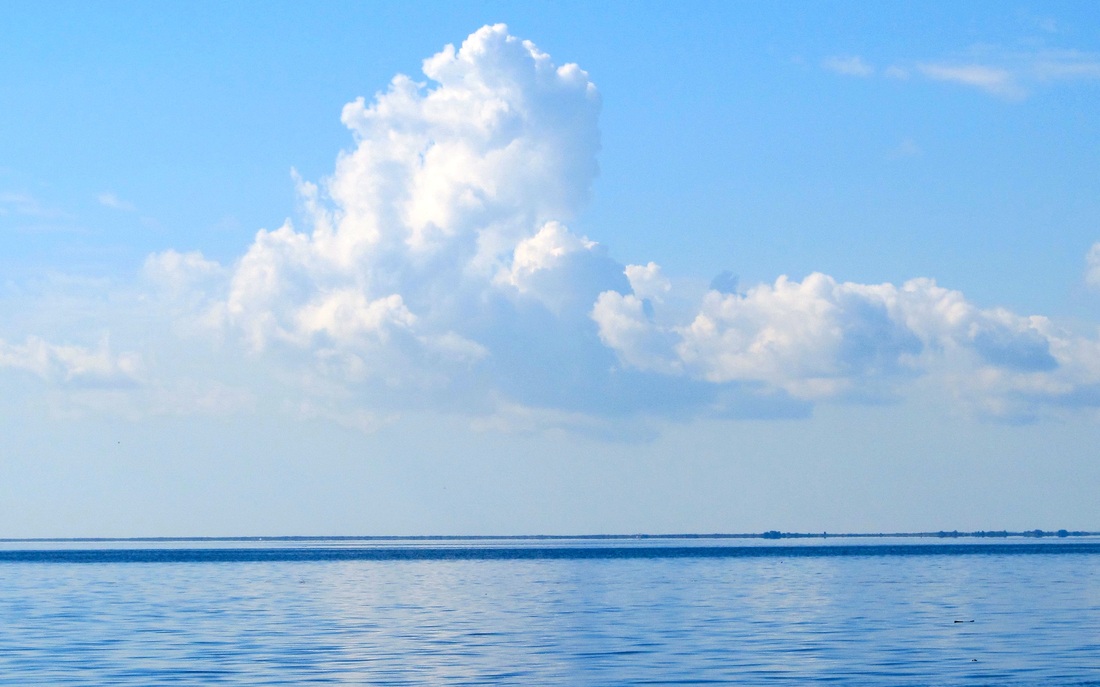The TEnnessee-Tombigbee Waterway
Sunday, October 19
At sunrise, a mist was blowing across Andiamo’s bow causing the dew to stick. The morning was cool with temperatures in the high 50’s, a clear sky and calm water. After a breakfast of oatmeal with all the fixings, the anchor was raised, and Andiamo headed to Grand Harbor Marina to re-set and for Paul and Stacy to go back to their lives in Athens, Georgia. We said our good-byes on the fuel dock. Great people and good friends.
With full tanks of water and diesel and an empty holding tank, Andiamo headed south on the Tenn-Tom Waterway, 450 water miles from Mobile, Alabama and halfway between St. Louis and New Orleans and Memphis and Nashville. The tug was on the Hubbard Branch of Pickwick Lake in the state of Mississippi under clear skies and cruising on flat and calm waters.
The lake ended at the start of a 27-mile long, 300 feet wide, and 10 feet deep channel that connects Pickwick Lake to Bay Springs Lake. This part of the Tennessee-Tombigbee Waterway took 7 years to dig and we were appreciative the huge cost and effort to build this alternative to the Mississippi River. “The Ditch” as it is known, cuts through a sparsely populated part of Mississippi, no houses, no boats, no people and no cell service.
30 miles after leaving Grand Harbor, Andiamo entered Bay Springs Lake and its slight southward current, deeper water and the scores of bays and coves that give the geese, turtles, herons and gulls a vibrant place to live. The destination was a small cove near the Whitten Lock and Dam and we found the Cutwater 28, Shipperly that was last seen in Green Turtle Bay. The anchor was dropped in 8 feet of water. A quiet late afternoon was followed by a light dinner of salad and grilled chicken.
Andiamo had traveled 43 miles.
At sunrise, a mist was blowing across Andiamo’s bow causing the dew to stick. The morning was cool with temperatures in the high 50’s, a clear sky and calm water. After a breakfast of oatmeal with all the fixings, the anchor was raised, and Andiamo headed to Grand Harbor Marina to re-set and for Paul and Stacy to go back to their lives in Athens, Georgia. We said our good-byes on the fuel dock. Great people and good friends.
With full tanks of water and diesel and an empty holding tank, Andiamo headed south on the Tenn-Tom Waterway, 450 water miles from Mobile, Alabama and halfway between St. Louis and New Orleans and Memphis and Nashville. The tug was on the Hubbard Branch of Pickwick Lake in the state of Mississippi under clear skies and cruising on flat and calm waters.
The lake ended at the start of a 27-mile long, 300 feet wide, and 10 feet deep channel that connects Pickwick Lake to Bay Springs Lake. This part of the Tennessee-Tombigbee Waterway took 7 years to dig and we were appreciative the huge cost and effort to build this alternative to the Mississippi River. “The Ditch” as it is known, cuts through a sparsely populated part of Mississippi, no houses, no boats, no people and no cell service.
30 miles after leaving Grand Harbor, Andiamo entered Bay Springs Lake and its slight southward current, deeper water and the scores of bays and coves that give the geese, turtles, herons and gulls a vibrant place to live. The destination was a small cove near the Whitten Lock and Dam and we found the Cutwater 28, Shipperly that was last seen in Green Turtle Bay. The anchor was dropped in 8 feet of water. A quiet late afternoon was followed by a light dinner of salad and grilled chicken.
Andiamo had traveled 43 miles.
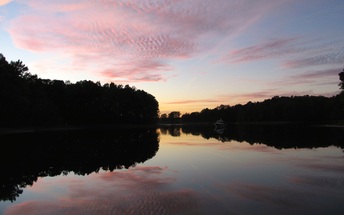
Monday, October 20
The morning confirmed that it was fall with a crisp 48 degrees, a heavy dew and fog. A tow with barges was below Whitten Lock and reported that he could not see the front of his tows. At 8 AM, the lockmaster gave us the option of locking through in the fog but we declined. The tow came through going northbound while we waited watching the chartplotter. Andiamo’s voltage on its house battery bank took a big dip to less than 11 volts. Apparently, the Garmin array of electronics draws a lot of amps. This was the first time we run the array without the engine running. Within 30 minutes of running the engine without the electronics running, the house bank of batteries was healthy once again.
We locked through 90 minutes later, dropping over 80 feet under clear skies. This is the first of a series of locks and the lockmasters communicate with each other so groups of boats go through together with a minimum wait. The locks create lines of change where the topography and often the human activity can be subtly different on one side of the lock from the other. Downstream of Whitten Lock, farms and a timber mill dotted the shoreline. After Montgomery Lock, the land was a thick forest. After Rankin Lock, we were re-introduced to the cypress tress with their roots that grow in the water that we had not seen Georgia and Florida last spring.
Given the choice of running another two hours or anchoring next to Wilkins Lock, we chose the later and dropped the anchor in 7 feet of water. Andiamo had traveled 37 miles.
Another seam on the canvas had a thread failure and the shower sump pump was fickle again. Those repairs closed the afternoon before cocktails in the cockpit. Just after sunset, another pleasure boat arrived and anchored very close to Andiamo, an irritant that would continue the next day. 90% of boaters are knowledgeable, thoughtful and courteous; sometimes the others have to be contended with. Laurie’s sinus infection knocked her done after dinner.
The morning confirmed that it was fall with a crisp 48 degrees, a heavy dew and fog. A tow with barges was below Whitten Lock and reported that he could not see the front of his tows. At 8 AM, the lockmaster gave us the option of locking through in the fog but we declined. The tow came through going northbound while we waited watching the chartplotter. Andiamo’s voltage on its house battery bank took a big dip to less than 11 volts. Apparently, the Garmin array of electronics draws a lot of amps. This was the first time we run the array without the engine running. Within 30 minutes of running the engine without the electronics running, the house bank of batteries was healthy once again.
We locked through 90 minutes later, dropping over 80 feet under clear skies. This is the first of a series of locks and the lockmasters communicate with each other so groups of boats go through together with a minimum wait. The locks create lines of change where the topography and often the human activity can be subtly different on one side of the lock from the other. Downstream of Whitten Lock, farms and a timber mill dotted the shoreline. After Montgomery Lock, the land was a thick forest. After Rankin Lock, we were re-introduced to the cypress tress with their roots that grow in the water that we had not seen Georgia and Florida last spring.
Given the choice of running another two hours or anchoring next to Wilkins Lock, we chose the later and dropped the anchor in 7 feet of water. Andiamo had traveled 37 miles.
Another seam on the canvas had a thread failure and the shower sump pump was fickle again. Those repairs closed the afternoon before cocktails in the cockpit. Just after sunset, another pleasure boat arrived and anchored very close to Andiamo, an irritant that would continue the next day. 90% of boaters are knowledgeable, thoughtful and courteous; sometimes the others have to be contended with. Laurie’s sinus infection knocked her done after dinner.
Tuesday, October 21
The sunrise brought clear skies, calm winds, flat water and fog but it lifted within the hour and we were in the Wilkins Lock by 8 AM. The Amory Lock was five miles away and halfway there; we met two tows passing each other. The channel was narrow and the southbound tow needed the entire width with its coal load of three barges wide and three barges long. Andiamo had to stay behind the tow and watched it go into the waiting lock. We dropped the anchor and waited 90 minutes for our turn to go through the lock.
Five additional pleasure boats joined us in the Armory Lock and Andiamo was part of an eight-boat flotilla. Andiamo and Shipperly, Ken and Pauline’s Cutwater 28, were the smallest boats in the flotilla with the others ranging from 60 to 40 feet. We quickly found out why the same size and type of boat makes a better group to cruise with when the bigger boats wanted a speed that was either inefficient or uncomfortable for us. The fix was to either power up and leave them all behind or to let them all go and do the slower speed that works for us; we did both.
There is no one good way to do the loop. Every looper does it their way and in a manner that works for them. Some loopers will stop every night at a marina, while others will anchor at every opportunity. Some will do 30 miles a day, while others will do 100 miles a day. Some loopers will always travel in a group that are formed in marinas or in locks and others are soloists who are happiest when traveling alone. Andiamo found it does not like flotillas of three or more. A group means that a leader or a committee makes decisions and though that works for others, decision-making is part of the allure of this adventure.
After Aberdeen Lock, the Tombigbee River was 500 feet wide, 12 feet deep and wandered. After the junction of the Buttahatchee River, houses and shoreline development dotted the shoreline. The destination was the Columbus Marina that is near the Columbus/Stennis Lock and Dam. Andiamo arrived in the mid-afternoon after travelling 43 miles.
Columbus Marina had about dozen looper boats, some we had seen before. We remembered the marina manager, T. Caldwell, who is known as “T” from 2008 and he remembered that our Ranger 25 tug was involved in a wreck on the way back to Seattle. (Check out that page on our website www.laurieann-ranger25.com). T is a native with memorable expressions, like, “Those two teams are like mules trying to eat the same turnip and we do not care which one wins.”
We had cocktails with Ken and Pauline on Andiamo and closed the evening with a light dinner.
The sunrise brought clear skies, calm winds, flat water and fog but it lifted within the hour and we were in the Wilkins Lock by 8 AM. The Amory Lock was five miles away and halfway there; we met two tows passing each other. The channel was narrow and the southbound tow needed the entire width with its coal load of three barges wide and three barges long. Andiamo had to stay behind the tow and watched it go into the waiting lock. We dropped the anchor and waited 90 minutes for our turn to go through the lock.
Five additional pleasure boats joined us in the Armory Lock and Andiamo was part of an eight-boat flotilla. Andiamo and Shipperly, Ken and Pauline’s Cutwater 28, were the smallest boats in the flotilla with the others ranging from 60 to 40 feet. We quickly found out why the same size and type of boat makes a better group to cruise with when the bigger boats wanted a speed that was either inefficient or uncomfortable for us. The fix was to either power up and leave them all behind or to let them all go and do the slower speed that works for us; we did both.
There is no one good way to do the loop. Every looper does it their way and in a manner that works for them. Some loopers will stop every night at a marina, while others will anchor at every opportunity. Some will do 30 miles a day, while others will do 100 miles a day. Some loopers will always travel in a group that are formed in marinas or in locks and others are soloists who are happiest when traveling alone. Andiamo found it does not like flotillas of three or more. A group means that a leader or a committee makes decisions and though that works for others, decision-making is part of the allure of this adventure.
After Aberdeen Lock, the Tombigbee River was 500 feet wide, 12 feet deep and wandered. After the junction of the Buttahatchee River, houses and shoreline development dotted the shoreline. The destination was the Columbus Marina that is near the Columbus/Stennis Lock and Dam. Andiamo arrived in the mid-afternoon after travelling 43 miles.
Columbus Marina had about dozen looper boats, some we had seen before. We remembered the marina manager, T. Caldwell, who is known as “T” from 2008 and he remembered that our Ranger 25 tug was involved in a wreck on the way back to Seattle. (Check out that page on our website www.laurieann-ranger25.com). T is a native with memorable expressions, like, “Those two teams are like mules trying to eat the same turnip and we do not care which one wins.”
We had cocktails with Ken and Pauline on Andiamo and closed the evening with a light dinner.
The next day, several of the looper boats had left at sunrise for the two to three day trip to Demopolis. After breakfast, the laundry was started, half of the tug’s hull and cabin was thoroughly cleaned, and the interior floors and carpets were cleaned. We tried to get a better Internet connection by being in the marina’s store-lounge. The stream of boaters, visits with the marina staff and overhearing great conversation got in the way of any productivity with the computer.
Ken and Pauline had reserved a courtesy car and we went with them to provision. Afterwards, a host of small projects were accomplished, as Andiamo’s systems always need some attention. Taking care of these tasks when they are small will typically head off the bigger problems. A float switch and a bilge pump was ordered to have on hand should the shower sump pump unit moves from being fickle to just stops working. Lots of talk about when to leave tomorrow and how to do the next leg to Demopolis because the trip is either three short days or two long days.
The four of us went to dinner at Huck’s in downtown Columbus as T had left one of the marina’s vehicle for us to use.
Ken and Pauline had reserved a courtesy car and we went with them to provision. Afterwards, a host of small projects were accomplished, as Andiamo’s systems always need some attention. Taking care of these tasks when they are small will typically head off the bigger problems. A float switch and a bilge pump was ordered to have on hand should the shower sump pump unit moves from being fickle to just stops working. Lots of talk about when to leave tomorrow and how to do the next leg to Demopolis because the trip is either three short days or two long days.
The four of us went to dinner at Huck’s in downtown Columbus as T had left one of the marina’s vehicle for us to use.
Two Days to Demopolis and Two Days There: Half Way through Alabama
Thursday, October 23
The collective of southbound looper boats agreed to leave the marina at 7AM and be in the nearby Stennis Lock shortly thereafter, barring any tows and barges. The morning was clear and cool and without fog. Five yachts and two smaller cruisers, Andiamo and Shipperly, went through the lock without a wait. Every lock signals a subtle change and the Stennis Lock brought water hyacinth, the invasive plant that was choking the St. John’s River in Florida. This floating plant is taking a hold on the Tenn-Tom Waterway and is nearly everywhere.
Andiamo would travel 66 miles that would be interesting, calm and peaceful. The river was rarely straight as it seemed to follow its historical route through the countryside, crossing back and forth across the boundary between Mississippi and Alabama. Houses were near the few roads and a few industrial sites, mostly sand loading operations or timber mills, were found on the banks. Three tows were passed and only a handful of fishing boats were seen in 8 hours of cruising. Bevill Lock was also waiting for the flotilla and we passed through easily.
But the topography and the wildlife were interesting. The river has its own pace and rhythm where time is the space between sunrises and sunsets, branded by storms and marked by the seasons. Cruising the river, the tug has its own rhythm of turning into curves as the diesel engine maintains its steady beat. Sometimes the forest and its ecosystem was the only elevation against the blue sky and the wispy white clouds. Other times, there were nearly 100 foot high bluffs that were attacked and cut by the river leaving the open wounds of erosion, slides, and trees that have fallen to the river’s edge that will take them downstream when the next raging storm comes.
Andiamo passed creeks and branches with names like Beaver Creek, Broken Pumpkin Creek, Lubbub Creek, Cochran Cutoff, Windham Landing, Upper Cook’s Bend, and Warsaw Cutoff. Where the river was wide the small cuts and creeks were ripe for exploration.
Laurie had identified three anchoring options as the destination. One of the yachts went to the only marina on this section. The other yachts had identified Sumpter Landing that was described as having a shallow but accessible opening and a scenic anchorage. The yachts were ahead of Andiamo and Shipperly because of their faster cruising speed. After we had checked three options, the yachts reported that they could not get into Sumpter landing because it was only 4 feet deep. Two of the yachts had drafts of nearly 6 feet. They were forced to wait at the nearby lock for a tow to get through so they could go to the next anchorage.
Andiamo and Shipperly slid through the Sumpter Landing’s narrow opening and across the mud bar with a foot to spare underneath the keel and dropped the anchors in 5 feet of water in a setting that was spectacular. Cocktails in the cockpit, showers, and grill brats closed the afternoon. A weak front brought clouds that turned the sky red and orange at sunset.
The collective of southbound looper boats agreed to leave the marina at 7AM and be in the nearby Stennis Lock shortly thereafter, barring any tows and barges. The morning was clear and cool and without fog. Five yachts and two smaller cruisers, Andiamo and Shipperly, went through the lock without a wait. Every lock signals a subtle change and the Stennis Lock brought water hyacinth, the invasive plant that was choking the St. John’s River in Florida. This floating plant is taking a hold on the Tenn-Tom Waterway and is nearly everywhere.
Andiamo would travel 66 miles that would be interesting, calm and peaceful. The river was rarely straight as it seemed to follow its historical route through the countryside, crossing back and forth across the boundary between Mississippi and Alabama. Houses were near the few roads and a few industrial sites, mostly sand loading operations or timber mills, were found on the banks. Three tows were passed and only a handful of fishing boats were seen in 8 hours of cruising. Bevill Lock was also waiting for the flotilla and we passed through easily.
But the topography and the wildlife were interesting. The river has its own pace and rhythm where time is the space between sunrises and sunsets, branded by storms and marked by the seasons. Cruising the river, the tug has its own rhythm of turning into curves as the diesel engine maintains its steady beat. Sometimes the forest and its ecosystem was the only elevation against the blue sky and the wispy white clouds. Other times, there were nearly 100 foot high bluffs that were attacked and cut by the river leaving the open wounds of erosion, slides, and trees that have fallen to the river’s edge that will take them downstream when the next raging storm comes.
Andiamo passed creeks and branches with names like Beaver Creek, Broken Pumpkin Creek, Lubbub Creek, Cochran Cutoff, Windham Landing, Upper Cook’s Bend, and Warsaw Cutoff. Where the river was wide the small cuts and creeks were ripe for exploration.
Laurie had identified three anchoring options as the destination. One of the yachts went to the only marina on this section. The other yachts had identified Sumpter Landing that was described as having a shallow but accessible opening and a scenic anchorage. The yachts were ahead of Andiamo and Shipperly because of their faster cruising speed. After we had checked three options, the yachts reported that they could not get into Sumpter landing because it was only 4 feet deep. Two of the yachts had drafts of nearly 6 feet. They were forced to wait at the nearby lock for a tow to get through so they could go to the next anchorage.
Andiamo and Shipperly slid through the Sumpter Landing’s narrow opening and across the mud bar with a foot to spare underneath the keel and dropped the anchors in 5 feet of water in a setting that was spectacular. Cocktails in the cockpit, showers, and grill brats closed the afternoon. A weak front brought clouds that turned the sky red and orange at sunset.
Friday, October 24
Andiamo was still in the small anchorage having not moved during the night. The morning was partly cloudy with no fog or dew. The AIS showed two tows using the Heflin Lock. An early start was not going to happen; time for a second pot of coffee. Again, the house battery bank had a dramatic drop of voltage when the electronics were turned on. The alternator on the diesel worked hard and was able to bring it all back to normal in about 10 minutes.
When the lockmaster was called an hour later, he said to join the two other approaching pleasure boats and the four boats would lock down together. At the lock, the lockmaster decided to hold the process and wait 30 minutes for a sailboat. They were from St. Louis, going to the Keys for the winter, and were apologetic as they only go 6.5 knots. Then, we waited another 15 minutes for a go-fast power cruising who was racing at 20 knots. Naturally, they would be the rude one and try to get out of the lock first by passing others inside the lock. The cruiser was from Florida and that explained everything. He had Christian symbols and wording on the stern and the contradiction of the message versus his actions was not lost.
The destination was the marina at Demopolis, Alabama and was 50 miles away. Andiamo was powered up to 15 MPH and ran for over an hour to shave an hour off the travel time so the tug could arrive in the late afternoon. The white cliffs at Epes were not only a change from the forested shoreline, but were striking because they were trimmed in the colors of autumn. About an hour from Demopolis, Laurie announced that Andiamo’s water tank was empty and it happened suddenly and unexpectedly. Puzzled, yet unaware of any problems, the tug continued on to the marina to fuel up and pump out.
At the fuel dock, water was added but the water pump ran without stopping, signaling that there was leak in the system. This was confirmed when the bilge pump kicked out several gallons of water. A look under the engine hood quickly found water spraying from a loose hose and that was fixed quickly. I was grateful that this event occurred today rather than during the trip to Mobile Bay when Andiamo was three days away from additional fresh water.
Andiamo moved over to the new marina and covered moorage having used 2 gallons per hour and earning 3 MPG since Grand Harbor. The tug had traveled 54 miles
Andiamo was still in the small anchorage having not moved during the night. The morning was partly cloudy with no fog or dew. The AIS showed two tows using the Heflin Lock. An early start was not going to happen; time for a second pot of coffee. Again, the house battery bank had a dramatic drop of voltage when the electronics were turned on. The alternator on the diesel worked hard and was able to bring it all back to normal in about 10 minutes.
When the lockmaster was called an hour later, he said to join the two other approaching pleasure boats and the four boats would lock down together. At the lock, the lockmaster decided to hold the process and wait 30 minutes for a sailboat. They were from St. Louis, going to the Keys for the winter, and were apologetic as they only go 6.5 knots. Then, we waited another 15 minutes for a go-fast power cruising who was racing at 20 knots. Naturally, they would be the rude one and try to get out of the lock first by passing others inside the lock. The cruiser was from Florida and that explained everything. He had Christian symbols and wording on the stern and the contradiction of the message versus his actions was not lost.
The destination was the marina at Demopolis, Alabama and was 50 miles away. Andiamo was powered up to 15 MPH and ran for over an hour to shave an hour off the travel time so the tug could arrive in the late afternoon. The white cliffs at Epes were not only a change from the forested shoreline, but were striking because they were trimmed in the colors of autumn. About an hour from Demopolis, Laurie announced that Andiamo’s water tank was empty and it happened suddenly and unexpectedly. Puzzled, yet unaware of any problems, the tug continued on to the marina to fuel up and pump out.
At the fuel dock, water was added but the water pump ran without stopping, signaling that there was leak in the system. This was confirmed when the bilge pump kicked out several gallons of water. A look under the engine hood quickly found water spraying from a loose hose and that was fixed quickly. I was grateful that this event occurred today rather than during the trip to Mobile Bay when Andiamo was three days away from additional fresh water.
Andiamo moved over to the new marina and covered moorage having used 2 gallons per hour and earning 3 MPG since Grand Harbor. The tug had traveled 54 miles
Saturday, October 25
A beautiful morning with clear blue skies and temperatures in the high 60’s that would climb to the mid-70’s. Fall is a wonderful time in this part of Alabama. After breakfast and walking the docks, two boat projects were worked on. The first project was the health of the house battery bank. Andiamo has four 110 amp, AGM batteries. Each battery was load tested and the only issue was several loose connections. Could this be the cause of low voltage after being at anchor and the heavy electrical loads are applied? Probably not but the fix should help. However, some old wiring that went to a water maker that was removed by the previous owner was pulled out. The second project was improving the vent line to the water tank because it was not free flowing. The progression of this assessment was stopped after determining that a trip through the refrigerator was necessary to access the deep bowels of the tug. That task will happen, just not today in Demopolis, Alabama.
The afternoon was spent doing a bike ride to the downtown. Demopolis is trying very hard to come back from despair with freshly paved streets, well cared for parks, and a hand full of interesting businesses. Their road to rebuilding is long and steep as the roots of poverty are deep and the lack of private investment is telling. Back at the marina, the boat was prepped for the next three days of no services or marinas. Laurie downloaded charts for final leg of the adventure, from Mobile Bay to Tarpon Springs, Florida.
We made the first significant action to going back to our universe in the Pacific Northwest by buying plane tickets for the return trip to Seattle. The arrangements to send Andiamo home are also starting; it will all happen in about a month.
Attending a traditional looper event of cocktails at 5PM where you bring your own beverage closed the afternoon. 20 people from about 10 different boats chatted and shared their stories. Of all the months of cruising and the thousands of miles traveled, this was our first attendance at such an event.
A beautiful morning with clear blue skies and temperatures in the high 60’s that would climb to the mid-70’s. Fall is a wonderful time in this part of Alabama. After breakfast and walking the docks, two boat projects were worked on. The first project was the health of the house battery bank. Andiamo has four 110 amp, AGM batteries. Each battery was load tested and the only issue was several loose connections. Could this be the cause of low voltage after being at anchor and the heavy electrical loads are applied? Probably not but the fix should help. However, some old wiring that went to a water maker that was removed by the previous owner was pulled out. The second project was improving the vent line to the water tank because it was not free flowing. The progression of this assessment was stopped after determining that a trip through the refrigerator was necessary to access the deep bowels of the tug. That task will happen, just not today in Demopolis, Alabama.
The afternoon was spent doing a bike ride to the downtown. Demopolis is trying very hard to come back from despair with freshly paved streets, well cared for parks, and a hand full of interesting businesses. Their road to rebuilding is long and steep as the roots of poverty are deep and the lack of private investment is telling. Back at the marina, the boat was prepped for the next three days of no services or marinas. Laurie downloaded charts for final leg of the adventure, from Mobile Bay to Tarpon Springs, Florida.
We made the first significant action to going back to our universe in the Pacific Northwest by buying plane tickets for the return trip to Seattle. The arrangements to send Andiamo home are also starting; it will all happen in about a month.
Attending a traditional looper event of cocktails at 5PM where you bring your own beverage closed the afternoon. 20 people from about 10 different boats chatted and shared their stories. Of all the months of cruising and the thousands of miles traveled, this was our first attendance at such an event.
Four Days to Mobile Bay
Sunday-Tuesday, October 26-28
Five boats agreed to leave the marina together and the Nordic 37 Tug Roxanne volunteered to take the lead on communicating with the Demopolis lock. Sunrise brought a light fog and the sound of diesels as other boats were leaving the marina also. The lockmaster told us that once a northbound tow had locked-through that we would be next. At the lock were five additional pleasure boats and one was over 100 feet long. Every boat was able to secure to the lock wall.
After transiting the lock, three fast boats pushed ahead at 15 to 20 MPH. A slow sailboat took up the rear and the rest of us were in the middle. Mobile Bay is over 200 miles south and the fast boats could probably make Bobby’s Fish Camp in one day and Mobile the next. The slow boats would take a full four or five days. Most boaters do this segment in three or three and half days. After the Demopolis Lock, none of the fast or slow boats were seen again.
Andiamo would do 73 miles the first day, 68 miles the second, 64 miles the third and 33 miles the fourth. The current pushed the tug along at 9 to 10 MPH, going with God, and getting great fuel economy.
Five boats agreed to leave the marina together and the Nordic 37 Tug Roxanne volunteered to take the lead on communicating with the Demopolis lock. Sunrise brought a light fog and the sound of diesels as other boats were leaving the marina also. The lockmaster told us that once a northbound tow had locked-through that we would be next. At the lock were five additional pleasure boats and one was over 100 feet long. Every boat was able to secure to the lock wall.
After transiting the lock, three fast boats pushed ahead at 15 to 20 MPH. A slow sailboat took up the rear and the rest of us were in the middle. Mobile Bay is over 200 miles south and the fast boats could probably make Bobby’s Fish Camp in one day and Mobile the next. The slow boats would take a full four or five days. Most boaters do this segment in three or three and half days. After the Demopolis Lock, none of the fast or slow boats were seen again.
Andiamo would do 73 miles the first day, 68 miles the second, 64 miles the third and 33 miles the fourth. The current pushed the tug along at 9 to 10 MPH, going with God, and getting great fuel economy.
Ken and Pauline, on their Cutwater 28 named Shipperly, would be our cruising companion for the whole trip to Mobile. We used channel 12 on the VHF to chat; Laurie was identifying birds and calling out alligators on Monday and Tuesday and Pauline would ask about the names of the tows that Andiamo’s AIS was identifying. We would discuss anchorage options using the Waterway Guides, Skipper Bob, Fred Meyer’s Nitty Gritty of the Tenn-Tom, and Active Captain. We often had drinks and crackers on Andiamo after the anchors were set.
Sunday afternoon Andiamo, Shipperly and Alabama Dream anchored at Picken’s Landing at mile marker 147. This is a wide section of the river and there is about 8 feet of depth between the green channel markers and the sandy shore. Our first choice was at Bashi Creek and two boats that had traveled faster than us took it. This anchorage was similar to the next night’s anchorage at Sunflower Cut-off where the tows know that pleasure boats often anchor off of the channel and will slow down as they pass during the night. The anchorage on Tuesday night was right out of Disneyland’s Safari Adventure. The Little Bayou Canot is about 100 feet wide with swamp vegetation hanging over the water. After the anchors were dropped in 14 feet of water, an alligator swam nearby and later the night was alive with crickets, owls and a sky full of stars.
The presence of wildlife indicates the health of the river. The first Anhinga (a bird that resembles a Cormorant) since Georgia was seen along with the first alligators on Sunday. Spanish Moss hanging from trees and palms that gives the south its classic look was seen the following day. The fall colors were gone after Monday. Tuesday brought vultures, kingfishers, more blue and white herons, terns, egrets, and crows.
The presence of wildlife indicates the health of the river. The first Anhinga (a bird that resembles a Cormorant) since Georgia was seen along with the first alligators on Sunday. Spanish Moss hanging from trees and palms that gives the south its classic look was seen the following day. The fall colors were gone after Monday. Tuesday brought vultures, kingfishers, more blue and white herons, terns, egrets, and crows.
This section of the Tennessee-Tombigbee Waterway has only one docking and fueling option at Bobby’s Fish Camp. This section is rural, nearly a wilderness, with minimal houses, and has a few clusters of industrial activity that is adjacent to a highway. Cell service exists only near the interstate freeways that crossed the river. Until Mobile, there are no full-service marinas. Anchor-phobic boaters find this section to be challenging, if not horrible as there are no restaurants, no showers and no restrooms. They endure the Tenn-Tom; we enjoyed it and found it to be delightful, scenic, interesting, and peaceful.
The names of the river’s features illustrate its heritage: Sugarnochee River, Kinterbrush Creek,Landrums Creek, Tuckabum Creek, Sugarbowa Creek, Tallallampa Creek, Okatuppa Creek, Ginhouse Island, Bilbo Island and Paul’s Bayou.
The names of the river’s features illustrate its heritage: Sugarnochee River, Kinterbrush Creek,Landrums Creek, Tuckabum Creek, Sugarbowa Creek, Tallallampa Creek, Okatuppa Creek, Ginhouse Island, Bilbo Island and Paul’s Bayou.
The river is straight for only short sections and the further south, the more oxbows the river made. On Tuesday, Andiamo covered miles but not significant distance. AIS was great to have to see the tows on the chartplotter rather than being surprised on a 90 degree turn with a set of barges that took nearly the entire width of the channel.
Coffeeville Lock was transited on Monday and it was first “of the last” things for this adventure being the last lock that Andiamo would go through. The tug has gone though nearly 100 locks on this adventure. The locks came in sets of similarity and each set was slightly different requiring different tie-up strategies and different roles by the crew. Going through the last lock was a bittersweet moment.
Coffeeville Lock was transited on Monday and it was first “of the last” things for this adventure being the last lock that Andiamo would go through. The tug has gone though nearly 100 locks on this adventure. The locks came in sets of similarity and each set was slightly different requiring different tie-up strategies and different roles by the crew. Going through the last lock was a bittersweet moment.
Wednesday-Thursday, October 29 and 30: TWO DAYS IN FAIRHOPE, ALABAMA
This would be a transition day where the wildness of the Tenn-Tom Waterway turns into the urban world of Mobile Bay. The weather was an element of this transition as the clear blue skies and become partly cloudy and the coolness of autumn would catch up with Andiamo. Shipperly and us pulled the anchors and glided out of the narrow and scenic bayou at 8AM. As we entered the river, Alabama Dream, the trawler that traveled and anchored with us to Picken’s Landing was there and this trio would go through Mobile Bay together.
This part of the Mobile River Delta was a great send-off because of the abundance of wildlife with ospreys and our first brown pelican since last spring and the diversity of plant life. The names that Andiamo passed included Little Bayou, Catfish Bayou, and Bayou Sara. There is virtually no elevation as the land is only a handful of feet above the water. The river is wide and flat and it’s current was moving Andiamo at nearly 10 MPH.
Within an hour, the skyline of Mobile popped out of the land and after a turn on the river, the chartplotter lighted up with 30 commercial tugs and freighter sending their AIS signals. We did this route 6 years ago in the Laurie Ann tug so the anxiety is minimal. Shipperly and Alabama Dream were following closely as we skirted the edges of the main channel, dodging tows, and taking in this busy, working harbor that is exporting wood products, loading coal, moving containers, and repairing huge ships in dry docks.
In 45 minutes, we were in the main body of Mobile Bay and we said our good-byes to Shipperly and Alabama Dream as Andiamo was going to the Eastern Shore Marina in Fairhope. Shipperly was going to Dog River Marina on the western shore and Alabama Dream was heading east on the ICW. We have been cruising with Ken and Pauline for over a week and enjoyed their company. Not only were our boats built by the same company, our cruising styles were compatible. This is another example of serendipity; the chance meeting of wonderful people and enjoying their company.
Mobile Bay is wider than Puget Sound but not as wide as Chesapeake Bay or the Great Lakes. Buoys do not mark the route to Fairhope; the autopilot would easily take Andiamo the eight miles and the depth would not exceed 7 feet under the tug’s keel. The fresh breeze that was predicted would be delayed; the bay was as flat as a mirror. The chop would come later in the evening and would rock Andiamo all night.
Eastern Shore Marina is not fancy, it is small and tucked away and our kind of place. The fuel prices were competitive and they matched the promotions of other marinas of offering one night of free moorage with fuel. Andiamo took a half a tank of diesel having used 1.8 gallons per hour and earning 4 MPG since Demopolis.
Andiamo traveled 33 miles. The afternoon was still and very hot, in the mid-90’s, and the huge thunderstorm clouds built over the region. Laurie spent the afternoon in town doing a major provisioning trip. I had a new float switch and bilge pump for the shower sump shipped to the marina and spent part of the afternoon swapping out the float switch. The new bilge pump went in the spare parts box. Two other boat projects filled the afternoon with cleaning the engine’s air cleaner and repairing the stitching on the canvas. Two harbor hosts who greet the loopers came to Andiamo and they shared their knowledge of marina and anchorages along Florida’s panhandle.
The Doppler radar showed the storm missed Fairhope and the breeze and chop would stay all night.
This would be a transition day where the wildness of the Tenn-Tom Waterway turns into the urban world of Mobile Bay. The weather was an element of this transition as the clear blue skies and become partly cloudy and the coolness of autumn would catch up with Andiamo. Shipperly and us pulled the anchors and glided out of the narrow and scenic bayou at 8AM. As we entered the river, Alabama Dream, the trawler that traveled and anchored with us to Picken’s Landing was there and this trio would go through Mobile Bay together.
This part of the Mobile River Delta was a great send-off because of the abundance of wildlife with ospreys and our first brown pelican since last spring and the diversity of plant life. The names that Andiamo passed included Little Bayou, Catfish Bayou, and Bayou Sara. There is virtually no elevation as the land is only a handful of feet above the water. The river is wide and flat and it’s current was moving Andiamo at nearly 10 MPH.
Within an hour, the skyline of Mobile popped out of the land and after a turn on the river, the chartplotter lighted up with 30 commercial tugs and freighter sending their AIS signals. We did this route 6 years ago in the Laurie Ann tug so the anxiety is minimal. Shipperly and Alabama Dream were following closely as we skirted the edges of the main channel, dodging tows, and taking in this busy, working harbor that is exporting wood products, loading coal, moving containers, and repairing huge ships in dry docks.
In 45 minutes, we were in the main body of Mobile Bay and we said our good-byes to Shipperly and Alabama Dream as Andiamo was going to the Eastern Shore Marina in Fairhope. Shipperly was going to Dog River Marina on the western shore and Alabama Dream was heading east on the ICW. We have been cruising with Ken and Pauline for over a week and enjoyed their company. Not only were our boats built by the same company, our cruising styles were compatible. This is another example of serendipity; the chance meeting of wonderful people and enjoying their company.
Mobile Bay is wider than Puget Sound but not as wide as Chesapeake Bay or the Great Lakes. Buoys do not mark the route to Fairhope; the autopilot would easily take Andiamo the eight miles and the depth would not exceed 7 feet under the tug’s keel. The fresh breeze that was predicted would be delayed; the bay was as flat as a mirror. The chop would come later in the evening and would rock Andiamo all night.
Eastern Shore Marina is not fancy, it is small and tucked away and our kind of place. The fuel prices were competitive and they matched the promotions of other marinas of offering one night of free moorage with fuel. Andiamo took a half a tank of diesel having used 1.8 gallons per hour and earning 4 MPG since Demopolis.
Andiamo traveled 33 miles. The afternoon was still and very hot, in the mid-90’s, and the huge thunderstorm clouds built over the region. Laurie spent the afternoon in town doing a major provisioning trip. I had a new float switch and bilge pump for the shower sump shipped to the marina and spent part of the afternoon swapping out the float switch. The new bilge pump went in the spare parts box. Two other boat projects filled the afternoon with cleaning the engine’s air cleaner and repairing the stitching on the canvas. Two harbor hosts who greet the loopers came to Andiamo and they shared their knowledge of marina and anchorages along Florida’s panhandle.
The Doppler radar showed the storm missed Fairhope and the breeze and chop would stay all night.
The next day was still breezy and the coolness of autumn had finally arrived. We took the marina’s courtesy car into Fairhope to walk, explore and Laurie got a haircut. Fairhope is the most vibrant small town that we have seen on this side of the country with a blend of retail, professional services, and sustaining of quality of life that is attractive.
The afternoon was catch up on chores, communicate and research the next leg of the trip. This month Andiamo had taken us nearly 1,000 miles and we have about 450 to go to cross our wake in Tarpon Springs, Florida.
The afternoon was catch up on chores, communicate and research the next leg of the trip. This month Andiamo had taken us nearly 1,000 miles and we have about 450 to go to cross our wake in Tarpon Springs, Florida.
Just for Fun and other Contradictions
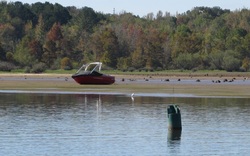
Is this a failure to follow the channel marker?
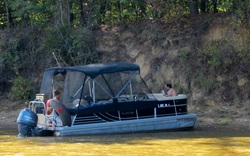
A simple and practical houseboat, Mississippi style.
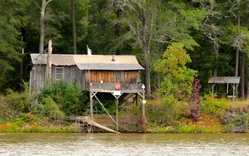
A project house on the Tombigbee River.
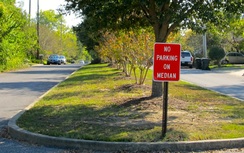
Do signs indicate the collective intelligence of a community?
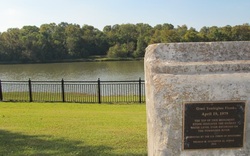
The top of this is the height of the river during a flood in 1979. The power of nature is frequently underestimated and under appreciated.
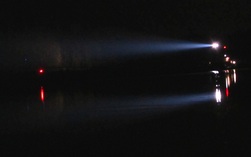
What a tug boat pushing 300 feet of barges in the middle of the night and on a narrow river channel looks like
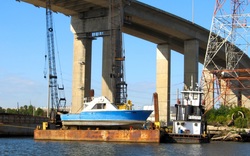
A boat on a barge, what is wrong with this picture?
